

Personalized Learning: What Is It? - Education Week Video – EdWeek.org. Psmag. How Teachers Are at the Core of Personalized Learning - Not Technology. One of the major complaints that I have heard in my community as we have adopted personalized learning relates to the idea that personalized learning means that we are adopting technology and getting rid of teachers.

There may be some places that are doing that, but my vision for personalized learning doesn’t include removing teachers – instead, it requires asking even more of teachers. I read an article by Rick Hess at EdWeek called, “A Confession and a Question on Personalized Learning.” He shares a letter from Larry Berger, CEO of Amplify, an EdTech company. The headline is a bit of clickbait, where the confession is really a recognition of what good educators have known for many years. He buried the “question” pretty deep in the letter, so I’ll bring it up here: How To Create Learning Playlists In A Textbook World. How To Create Learning Playlists by Terry Heick The idea of playlists became popular with the explosion of iTunes and YouTube in the last decade.
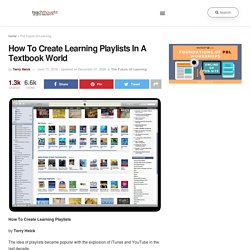
Before music became digital, it was bound by its physical restrictions. Record players required users to pick up and move the needle, cassette players forced users to rewind or fast-forward to certain songs (the humanity), and even CD players simply accelerated this process by allowing for faster track selection, and faster moving across and within tracks. With digital music, listeners could not only move more quickly between songs but could cherry-pick them from certain ‘albums’ to listen to. It’s Time to Take Back Personalized Learning. In what no doubt feels like an ironic twist for most teachers, the concept of personalized learning has come under fire.

The term has become derided as emblematic of a technological takeover of education—with the potential to sap the humanity from teaching. But teachers know personalized learning is designed to enable the sort of flexibility children deserve, and provide space to adjust the format and structure of lessons to fit each student’s needs. The modern push toward personalized learning started in the 1960s and 70s, when some teachers began practicing what they called “individualized instruction.” Stop Trying to Define Personalized Learning. No.
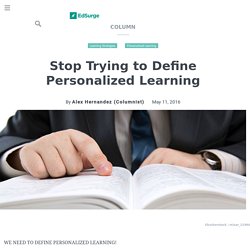
No we don’t. While personalized learning (PL) may be a “thing,” it is not a thing. As of today, PL is a set of loosely-related (sometimes completely unrelated) hypotheses. Educators, families and funders are testing to see if we can do better than the traditional classroom model of putting 20-30 similarly-aged students in a room with one adult for about an hour. Stop Trying to Define Personalized Learning (Ed... What personalized learning in the classrooms look like with creative teaching methods? They need a different perspective on education, with an instructional support providing subject matter mastery.
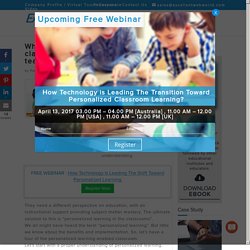
The ultimate solution to this is “personalized learning in the classrooms”. We all might have heard the term “personalized learning”. But little we know about the benefits and implementation. Why do teachers implement personalized learning? What Is 'Personalized Learning'? Educators Seek Clarity. Four Reasons to Worry About "Personalized Learning" Tocqueville’s observations about the curious version of democracy that Americans were cultivating in the 1830s have served as a touchstone for social scientists ever since.

One sociologist writes about the continued relevance of what Tocqueville noticed way back then, particularly the odd fact that we cherish our commitment to individualism yet experience a “relentless pressure to conform.” Each of us can do what he likes as long as he ends up fundamentally similar to everyone else: You’re “free to expand as a standardized individual.”[1] A couple of decades ago, that last phrase reminded me of how our pitiful individuality was screwed to the backs of our cars in the form of customized license plates. Today it brings to mind what goes by the name “personalized learning.” A suffix can change everything. Personalized Data Units or Personal Learning? – Education Reform – Medium. “The assumption here is that curriculum can be broken into little pieces, that skills are acquired sequentially and can be assessed with discrete, contrived tests and reductive rubrics.
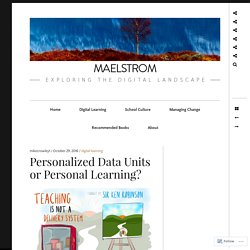
Tracking kids’ “progress” with digital profiles and predictive algorithms paints a 21st-century gloss on a very-early-20th-century theory of learning.” – Alfie Kohn The semantics of school reform are sometimes deceptive. Alma Takes Personalized Learning to the Next Level with Student Choice – The Edvocate. Special Report: Personalized Learning: The Next Generation. The push to design teaching and learning around students’ distinctive academic needs, and even their personal interests, is no longer only happening in pockets of experimentation around the country.
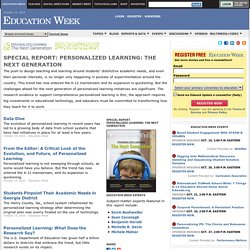
This trend has now entered the K-12 mainstream and its expansion is quickening. But the challenges ahead for the next generation of personalized learning initiatives are significant. The research evidence to support comprehensive personalized learning is thin, the approach requires big investments in educational technology, and educators must be committed to transforming how they teach for it to work. The evolution of personalized learning in recent years has led to a growing body of data from school systems that have had initiatives in place for at least a few years. October 19, 2016 – Education Week. Schools have no choice but to personalize learning. Personalized Learning Through the Eyes of a Child.
Guest Post by Pam Lowe, Educator, Marketing Associate, and Personalized Learning Coach We’re learners even before the moment we are born.
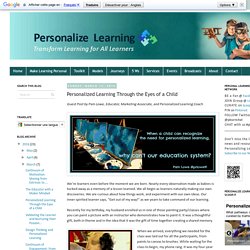
Nearly every observation made as babies is tucked away as a memory of a lesson learned. We all begin as learners naturally making our own discoveries. We are curious about how things work, and experiment with our own ideas. Our inner spirited learner says, “Get out of my way!” Recently for my birthday, my husband enrolled us in one of those painting party/classes where you can paint a picture with an instructor who demonstrates how to paint it. When we arrived, everything we needed for the class was laid out for all the participants, from paints to canvas to brushes. Get Rid of Grade Levels: A Personalized Learning Recipe for Public School Districts. Public schools play a huge role in developing learners to be successful when they leave school.
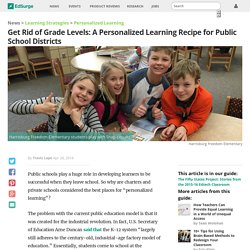
So why are charters and private schools considered the best places for “personalized learning”? The problem with the current public education model is that it was created for the industrial revolution. In fact, U.S. Secretary of Education Arne Duncan said that the K-12 system “largely still adheres to the century-old, industrial-age factory model of education.”
Essentially, students come to school at the elementary level excited about learning—but become disengaged by the time they get to high school, as evidenced by the graph to the right. Continuum of Self-Efficacy: Path to Perseverance. Self-efficacy holds significant implications both for learners and educators in the journey to nurture high levels of skill and knowledge. The most difficult and challenging learner to teach is the learner who believes he or she cannot succeed. Continuum of Self-Efficacy TM by Barbara Bray and Kathleen McClaskey is licensed under a Creative Commons Attribution-NonCommercial-NoDerivatives 4.0 International License. Based on work at bit.ly/continuum-self-efficacy * Graphic design by Sylvia Duckworth. For this learner, developing challenging and complex skills and concepts is a task to be avoided.
If success does not come on the first attempt, these learners easily conclude that learning is not possible and abandon their efforts. Cautious. UDL Resources for Middle Schools. Home. 5 Apps to Transform Teaching and Personalize Learning. Transformation requires a journey for teachers toward great educational rewards for students. Knowing how to craft learning experiences that meld technology with the curriculum is key to crafting digital-age lessons.
As digital tools are integrated seamlessly with sound pedagogical practice, a new classroom culture emerges. This is a culture focused on student-centered, personalized learning and shifting away from traditional teacher-centered classrooms. The digitally-rich lesson format below has evolved as technology has been infused into these lesson components: Whole-group instruction Guided practice Independent practice Reflection 1. Whole-group instruction has traditionally been delivered in lecture format: the teacher stands in front of the class and presents the same lesson to everyone at the same time.
Nearpod is a free presentation tool available for all computers, tablets, and phones. 2. Research shows that timely and immediate feedback has a significant impact on learning. 3. 5 Apps to Transform Teaching and Personalize Learning. Continuum of Engagement: From Compliant to Flow. The Continuum of Engagement provides the characteristics of a learner as they move from being passive about learning to being in the flow. How do we know learners are engaged? Step up the ladder to see how a learner moves from compliant to flow so you can picture what it looks and sounds like in a classroom when learners start engaging in the learning process.
If you walk in a classroom, you might be able to see and hear engagement or the lack of it. Compliant In a Compliant level, the teacher is probably following the curriculum and doing what they know or learned in their teacher education program. Commit When learners are in the Commit level, you will see learners in pairs, groups, or working individually.
Connect. Part 5: 12 Tech Ideas and Tools for Differentiated Learning … Online Discussions. Welcome to the fifth post in a series designed to support the use of technology for differentiated learning… in and beyond the PBL classroom. Before reading, please take a moment to subscribe by email or RSS and also give me a follow on Twitter at mjgormans. I promise you will find some great information coming your way in the posts that follow…So sign up now and please pass this on with a retweet. – Mike Gorman ( Booking Info – It is time to think about your school or conference needs. Are you looking for a practical and affordable professional development workshop for your school or conference? I have traveled the country delivering PD relating to technology integration, PBL, STEM, Digital Literacy, and the 4 C’s.
Personalized Learning Isn't About Isolation. Published Online: February 23, 2016 Published in Print: February 24, 2016, as Personalization Isn't About Isolation Commentary By Jennifer Carolan. The Five Tenets of Personalized Learning. Cross-posted from the Corwin Connect Blog. I did not know what I was doing when I decided to change the way I taught. I did not know that somewhere out in the education world there was already a term floating around for some of the ideas I had for change, a term that would capture so many of my ideas in one. Step by Step: Designing Personalized Learning Experiences For Students. What Do We Really Mean When We Say ‘Personalized Learning’? The idea of personalized learning is seductive – it implies moving away from the industrialized form of education that pumps out cookie-cutter students with the same knowledge and skills.
After decades of this approach, it is clear that all children don’t learn the same way and personalization seems to honor those differences. However, that term has taken on several different meanings. Continuum of Voice: What it Means for the Learner. Voice gives learners a chance to share their opinions about something they believe in. We adapted the Continuum of Voice chart we used from research from Toshalis and Nakkula at the Students at the Center in our post Learner Voice Demonstrates Commitment to Building Agency. Middletown, NY Personalizes Learning To Narrow Achievement Gaps - Lexington Institute. Click here to download the full study as PDF. The Enlarged City School District of Middletown, New York is showing the nation how to transform a once-struggling district. Proving that good things come in small packages, this economically challenged district is improving on important metrics — for example, 4-year high school graduation rates have increased from 51 to 80 percent over the past nine years.
Math instruction meets a personalized approach. Education Week. Step by Step: Designing Personalized Learning Experiences For Students.